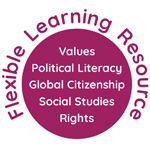Research question:
All children have rights. Do children around the world have the same access to these rights?
Resources Levels 2-3
Core Activities
- We Are All Born Free film (4 mins), PowerPoint and activity
- Images of rights enjoyed or denied, presentation and student sheet
- Freedom of Expression and Right to be Safe: presentation
Extension Activities
Notes on Core Activities
Activity one: Global Citizenship (Oxfam lesson 1) This activity is a basic introduction to global citizenship. Learners discuss 9 points to help them realise their potential to change things for the better. Global Citizenship (Oxfam lesson 2) The second activity helps learners understand how they link with the wider world in their daily life.
Activity two: We Are All Born Free (Amnesty) Amnesty have produced an introduction to the Universal declaration of Human Rights. Learners watch the film (4 mins), and look at the pictures on the PowerPoint presentation. They then write a short story about their rights inspired by one of the pictures.
Activity three: Images of rights enjoyed or denied. Learners look at the pictures in the presentation, Images of Rights and consider what they see and how they link to the guiding principles of the United Nations Convention on the Rights of the Child.
Activity four: Freedom of Expression and the Right to be Safe. Learners consider conflicting rights and produce ground rules to ensure no negative attitudes, language or behaviour results from study of conflict in Palestine and Israel.
Extension Activities
Activity one: Three Wishes: Palestinian and Israeli Children Speak. Learners read the case studies and consider: what rights being enjoyed or denied and the differences and similarities between the children.
Activity two: Anne Frank Declaration (Anne Frank Trust). Learners may choose to sign up to the Anne Frank Declaration or write their own version.
